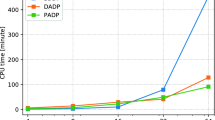Abstract
This nested decomposition algorithm is intended for solving linear programs with the staircase structure that is characteristic of dynamic multi-sector models for economic development. Staircase problems represent a special case of the discrete-time optimal control problem. Our method is based upon the same principles as that of Glassey [5], but appears easier to describe and to relate to control theory.
Computational experience is reported for a series of test problems. The algorithm has been coded in MPL, an experimental language for mathematical programming. This translator has made it possible to obtain a more readable program — and with fewer instructions — than one written in a conventional language. However, because the present version of MPL does not permit the use of slow access memory, this has prevented us from exploring the full potential of nested decomposition for solving larger problems than can be handled by conventional simplex techniques.
Similar content being viewed by others
References
G.B. Dantzig,Linear programming and extensions (Princeton University Press, Princeton, N.J., 1963).
G.B. Dantzig, T. Magnanti and S. Maier, “A user's guide to MPL/T.1”, Paper No. 76, Graduate School of Business Administration, Duke University, Durham, N.C. (December 1972).
G.B. Dantzig and P. Wolfe, “The decomposition algorithm for linear programs”,Econometrica 29 (1961) 767–778.
C.R. Glassey, “Nested decomposition and multi-stage linear programs”,Management Science 20 (1973) 282–292.
C.R. Glassey, “Dynamic linear programs for production scheduling”,Journal of the Operations Research Society of America 19 (1971) 45–56.
H. Halkin, “A maximum principle of the Pontryagin type for systems described by nonlinear difference equations”,SIAM Journal on Control 4 (1966) 90–111.
A.S. Manne, “Sufficient conditions for optimality in an infinite horizon development plan”,Econometrica 38 (1970) 18–38.
M. Simmonard,Linear programming (Prentice-Hall, Englewood Cliffs, N.J., 1966).
Author information
Authors and Affiliations
Additional information
Prepared under National Science Foundation Grant GS-30377 at the Institute for Mathematical Studies in the Social Sciences, Stanford University.
Rights and permissions
About this article
Cite this article
Ho, J.K., Manne, A.S. Nested decomposition for dynamic models. Mathematical Programming 6, 121–140 (1974). https://doi.org/10.1007/BF01580231
Received:
Revised:
Issue Date:
DOI: https://doi.org/10.1007/BF01580231




